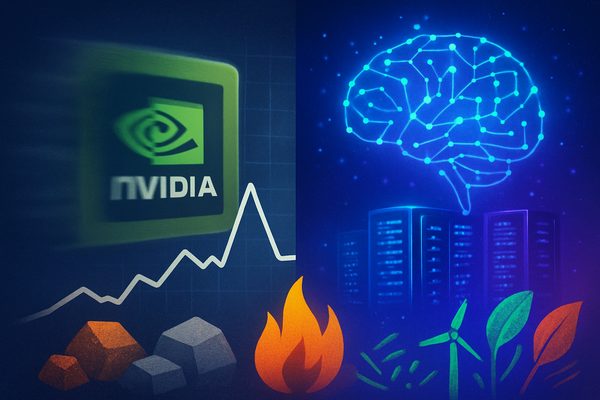The Great Rotation: Capital Shifts from Tech to Traditional Industries, Reshaping Market Dynamics

As of November 11, 2025, the financial markets are witnessing a significant and ongoing rotation of investment capital, moving away from the high-flying technology sector, including Artificial Intelligence (AI) powerhouses, and into more established, traditional industries. This pivotal shift is primarily driven by escalating valuation concerns within the tech space and evolving macroeconomic conditions that are prompting investors to seek out value and fundamental strength in other segments of the market. The immediate implication of this rebalancing act is a noticeable divergence in the performance of major market indices, with the tech-heavy Nasdaq Composite experiencing pressure while the industrially-focused Dow Jones Industrial Average gains momentum.
This strategic reallocation of funds, which has been steadily building since late 2024, signals a potential recalibration of market leadership. Investors are increasingly wary of the lofty valuations that have characterized many technology firms, particularly those at the forefront of the AI boom, prompting a reassessment of risk and reward. The move towards sectors like financial services, energy, industrials, and healthcare reflects a broader quest for diversification and a more sustainable growth trajectory, indicating a maturing market sentiment that prioritizes established profitability and tangible assets over speculative growth.
Detailed Coverage of the Event
The current investment rotation, gaining significant momentum since late 2024, represents a strategic pivot by major market players away from the once-unassailable technology sector. This shift is particularly pronounced in areas linked to Artificial Intelligence (AI), where investor exuberance has given way to a more cautious assessment of valuations and growth sustainability. A key indicator of this shift was observed in late July 2025, when hedge funds executed their largest weekly sell-off in technology stocks in a year, exiting long positions across semiconductor firms, software, and IT services, particularly in North America and Europe. This wasn't a shorting spree but rather a deliberate move to lock in profits and reduce exposure to a sector perceived as overextended.
On the very day of November 11, 2025, tangible evidence of this rotation emerged with significant corporate actions and market reactions. SoftBank Group (TYO: 9984) confirmed the sale of its entire $5.83 billion stake in Nvidia (NASDAQ: NVDA), a move that sent ripples through the market and contributed to a decline in Nvidia's shares. This high-profile divestment fueled fears that institutional investors are actively cashing in on the substantial gains accumulated during the AI surge of 2023-2024. Simultaneously, CoreWeave, a prominent player in AI infrastructure, saw its shares plunge after issuing a warning that data-center supply bottlenecks would restrict its growth throughout 2025, highlighting the real-world operational challenges and supply chain dependencies faced by even the most promising AI-linked companies.
The immediate market reactions on November 11, 2025, clearly underscored this divergence. The Nasdaq Composite, heavily weighted with technology and growth stocks, slid under the pressure of weakening tech shares and a growing skepticism surrounding the sustainability of the "AI trade." In stark contrast, the Dow Jones Industrial Average (DJIA), with its greater exposure to traditional industries, registered gains. This upward movement in the Dow was bolstered by defensive and energy-heavy constituents such as Chevron (NYSE: CVX), IBM (NYSE: IBM), and McDonald's (NYSE: MCD), as investors actively rotated into value stocks perceived as more stable and less susceptible to the tech sector's volatility. The S&P 500 (NYSEARCA: SPY), a broader market index, traded unevenly, reflecting the conflicting forces of tech sector struggles and gains in other areas, underscoring a market seeking new leadership beyond the concentrated gains of a few mega-cap tech giants.
Companies Winning and Losing from the Great Rotation
The ongoing investment rotation is creating a clear bifurcation in the market, distinguishing between companies poised to benefit from renewed investor interest in traditional sectors and those in the technology realm facing headwinds from valuation scrutiny and shifting capital flows. The high-growth AI and broader tech sectors, which have enjoyed years of unparalleled expansion, are now experiencing a recalibration. Companies like Nvidia Corporation (NASDAQ: NVDA), a titan in AI chip manufacturing, have seen significant stock declines, including a sharp crash in early November 2025, wiping out hundreds of billions in market capitalization. The doubts surrounding the immediate returns from massive AI spending and a general fatigue with stretched valuations are key drivers. Microsoft Corporation (NASDAQ: MSFT), despite its robust cloud and AI offerings, has also faced its longest losing streak in a decade, with an 8-day sell-off in early November 2025, as investors grow wary of escalating capital expenditures in AI infrastructure. Other AI-linked and semiconductor firms such as Palantir Technologies (NYSE: PLTR), Arm Holdings (NASDAQ: ARM), Advanced Micro Devices (NASDAQ: AMD), Broadcom Inc. (NASDAQ: AVGO), and Super Micro Computer (NASDAQ: SMCI) have similarly experienced declines, reflecting a cooling in investor enthusiasm. These tech companies may need to adjust their business strategies, focusing more intently on clear pathways to profitability for their AI investments and potentially scaling back on some high-cost R&D initiatives as capital becomes more discerning.
Conversely, traditional industries are experiencing a resurgence, attracting substantial capital as investors seek stability, value, and less speculative growth. In the financial services sector, major players like JPMorgan Chase & Co. (NYSE: JPM) and PNC Financial Services Group (NYSE: PNC) are gaining momentum, benefiting from a potentially more stable interest rate environment and renewed interest in traditional lending and investment banking. The energy sector, critical for powering the burgeoning AI data centers, is also a significant beneficiary. Integrated oil majors such as ExxonMobil (NYSE: XOM) and Chevron (NYSE: CVX) are poised to capitalize on robust global demand and the structural increase in energy needs driven by AI infrastructure. Their business strategies will likely focus on increasing production and improving shareholder returns.
Industrials are another winning sector, buoyed by significant "non-tech capital expenditure" surges. Companies in this space are benefiting from government spending on infrastructure, a global push for manufacturing revitalization (reshoring), and the integration of AI-powered automation in "smart factories." This includes firms providing robotics, smart factory solutions, defense contractors, and construction equipment manufacturers. The healthcare sector, represented by giants like UnitedHealth Group (NYSE: UNH) and Johnson & Johnson (NYSE: JNJ), remains a defensive stronghold, offering long-term growth drivers from aging populations and continuous innovation in biotechnology and digital health. Basic materials companies, such as Sherwin-Williams (NYSE: SHW) and DuPont de Nemours (NYSE: DD), are also seeing increased momentum, supported by a higher trend level of demand for tangible assets tied to industrial and construction activity. Finally, consumer staples, including Coca-Cola (NYSE: KO), Procter & Gamble (NYSE: PG), and Church & Dwight Co. (NYSE: CHD), are attracting investors seeking stable demand and consistent returns, offering a defensive hedge in uncertain times. This shift underscores a broader market maturation, where diversification and fundamental strength are once again paramount.
Wider Significance and Broader Industry Trends
The ongoing investment rotation, a "Great Sector Rotation" as some analysts are calling it, signifies a profound recalibration of market expectations and a maturing economic cycle rather than a mere fleeting trend. For years, market leadership was heavily concentrated in a select group of technology giants, often dubbed the "Magnificent Seven." The current shift, however, points towards a broadening market rally and a more diversified economic landscape, underscoring the cyclical nature of markets where different sectors rise and fall in prominence during distinct phases of the business cycle. This movement is fueled by persistent yet easing inflationary pressures, the anticipation of measured interest rate adjustments by global central banks, and a critical re-evaluation of elevated valuations within the tech sector. Higher interest rates, even if gradually declining, inherently reduce the present value of future earnings, disproportionately impacting growth stocks whose valuations are heavily reliant on long-term projected cash flows, while favoring value stocks with more stable, immediate earnings.
The ripple effects of this rotation are reshaping competitive landscapes and partnership dynamics across industries. For technology companies, particularly smaller AI startups, this means increased scrutiny and potentially reduced access to capital, forcing a more stringent focus on demonstrable profitability rather than speculative growth. This environment could lead to consolidation, with larger, more established tech firms acquiring struggling startups at reduced valuations. Even tech giants like Apple (NASDAQ: AAPL), Alphabet (NASDAQ: GOOGL), and Microsoft (NASDAQ: MSFT), while better equipped to weather the storm due to their diversified revenue streams and substantial cash reserves, are experiencing institutional capital outflows. Conversely, traditional industries are experiencing a surge in investment and improved access to capital for expansion. Companies in value and defensive sectors are finding it easier to fund operational improvements and strategic initiatives, particularly those that strategically integrate AI for efficiency and innovation. For example, increased capital expenditure in the energy sector, driven by higher commodity prices, directly benefits oilfield service companies and equipment manufacturers.
From a regulatory and policy standpoint, the investment shift and evolving technological landscape introduce significant considerations. The U.S. presidential election in early 2025 and a potentially Republican-controlled administration have introduced policy uncertainty, with anticipated deregulation and tax incentives potentially driving mergers and acquisitions in tech, particularly in scalable innovation-driven areas like AI, SaaS, and cybersecurity. However, the tech sector also faces increasing regulatory scrutiny, leading to longer approval timelines for M&A activity. Crucially, governments worldwide are grappling with the ethical deployment of AI, data privacy concerns, and the concentration of power among dominant AI developers. Regulations like the EU AI Act are mandating transparency and risk management, directly impacting AI companies. Historically, this rotation echoes past market cycles, particularly the dot-com bubble burst in the early 2000s, where speculative tech stocks were severely re-evaluated, leading to a rotation into more fundamentally sound companies. The inverse relationship between rising interest rates and growth stock valuations has been observed repeatedly, and the current environment suggests a return to historical patterns where value investing can outperform growth over extended periods following sustained growth dominance. Warren Buffett's actions in early 2025—increasing his cash pile and selling Apple stock—are viewed by some as a cautionary signal, reminiscent of his prescient moves before past market corrections.
What Comes Next: Navigating the New Market Landscape
As of November 2025, the market's strategic pivot away from technology and into traditional industries sets the stage for a period of dynamic shifts, presenting both significant opportunities and formidable challenges for investors and businesses alike. In the short term, extending through mid-2026, market participants should anticipate continued volatility and rapid changes in leadership. "Smart money" is actively rebalancing portfolios, with a noticeable sell-off in growth-oriented equities, including biotechnology and certain AI plays, leading to a reallocation of capital. This means continued strength is likely for value and cyclical sectors such as financial services, energy, industrials, and healthcare, which are poised to benefit from moderating interest rates and increased capital market activity. Defensive sectors like utilities and consumer defensives may also see sustained interest as investors seek stability. A notable short-term possibility is the outperformance of emerging markets, driven by robust growth, attractive valuations, and easing financial conditions, with India and Indonesia highlighted as strong contenders.
Looking further out, beyond mid-2026, the long-term outlook suggests a complex environment shaped by structural shifts rather than mere cyclical adjustments. The era of concentrated tech leadership is likely to be replaced by a market with broader participation, underscoring the enduring importance of diversification across asset classes, sectors, and geographies. While the "easy money" from tech's outsized returns may be behind us, the sector is not "done"; secular trends like cloud computing, advanced AI, cybersecurity, and quantum computing will continue to drive innovation, but with a stronger investor emphasis on profitability and disciplined growth. An infrastructure super-cycle, fueled by AI needs, reshoring initiatives, and sustainable development, is expected to be a key driver for the next market cycle, particularly benefiting industrials and related sectors. Demographic shifts, such as an aging global population, will also drive long-term growth in sectors like healthcare, including medical technology and pharmaceuticals.
To thrive in this evolving environment, both investors and businesses will need to implement strategic pivots and adaptations. For investors, this means moving beyond mega-cap tech and diversifying into U.S. cyclical, smaller-cap, and value stocks, as well as non-U.S. markets, including rotating international equity exposure from developed to emerging markets. A focus on quality and fundamentals—companies with strong balance sheets, pricing power, and clear pathways to cash flow—will be paramount. Active management and selectivity, particularly in emerging markets, may prove more effective than passive strategies. Businesses, especially in the tech sector, will need to adapt by demonstrating clearer paths to profitability for their AI investments, potentially scaling back on speculative R&D, and exploring strategic consolidations. Traditional industries, on the other hand, should capitalize on increased access to capital to invest in operational improvements, AI integration, and expansion initiatives.
Market opportunities will emerge in areas like AI enablers and infrastructure providers (e.g., semiconductors, data centers, advanced cooling solutions), value and dividend stocks, and small- and mid-cap equities with attractive valuations. Challenges will include a projected moderation in global GDP growth, persistent elevated valuations in some U.S. large-cap growth segments, and ongoing geopolitical risks that could lead to increased tariffs and supply-chain constraints. Potential scenarios range from a "soft landing" with broadened market leadership to renewed stagflationary pressures or, less likely, a new tech surge with a focus on profitability. A sharper-than-expected economic slowdown could lead to a broad market downturn, while a scenario of emerging markets dominance, driven by their stronger growth, remains a compelling possibility. The investment environment demands a strategic and adaptable approach, moving away from past market concentration towards a diversified portfolio resilient to both economic shifts and geopolitical realities.
Comprehensive Wrap-up
The investment rotation currently underway, as of November 11, 2025, marks a pivotal shift in financial markets, moving away from the prolonged dominance of technology stocks and towards more traditional, fundamentally strong industries. This rebalancing act, which has gained momentum throughout 2025, reflects a critical reassessment of valuations, particularly within the Artificial Intelligence (AI) sector, and a response to evolving macroeconomic conditions. Key takeaways include the distinct underperformance of tech stocks, such as the Nasdaq Composite experiencing its steepest weekly decline since March in the week leading up to November 9, 2025, contrasted with the robust rise of traditional and value sectors like financial services, energy, and industrials. Macroeconomic drivers, including persistent inflation concerns despite the Federal Reserve's October 2025 rate cut, and new tariffs, have significantly influenced this rotation. Crucially, the improved market breadth, with broader participation beyond the "Magnificent Seven" (Apple (NASDAQ: AAPL), Microsoft (NASDAQ: MSFT), Nvidia (NASDAQ: NVDA), Amazon (NASDAQ: AMZN), Alphabet (NASDAQ: GOOGL), Meta Platforms (NASDAQ: META), and Tesla (NASDAQ: TSLA)), suggests a healthier and more diversified market foundation.
Moving forward, market strategists widely anticipate that this rotation theme will persist through late 2025 and into 2026. A "compelling case for large-cap value stocks" is emerging as the economic cycle matures, favoring companies with strong fundamentals, stable earnings, and reasonable valuations over ultra-expensive growth names. The market's focus is expected to shift from the rapid "buildout" of AI infrastructure to identifying companies that can effectively utilize AI to improve products, services, and drive top-line growth. While J.P. Morgan Research forecasts the S&P 500 to close near 6,000 by year-end 2025, supported by double-digit earnings growth, ongoing trade policy and geopolitical risks remain significant. Global diversification into international equities and emerging markets is increasingly highlighted as crucial for navigating this complex environment.
The lasting impact of this investment rotation is profound. It signifies more than a temporary market fluctuation; it represents a fundamental recalibration of market dynamics, moving towards broader-based economic participation after years of narrow, tech-led rallies. This reinforces the cyclical nature of markets and underscores the enduring importance of a diversified investment portfolio. The growing sentiment that the AI rally might have entered "bubble territory" is leading to a cautious reassessment of high-flying tech valuations and could trigger a substantial, lasting rotation into more defensive, dividend-yielding assets. The increasing unreliability of traditional economic patterns further solidifies sector rotation as a critical, agile strategy for investors in a fast-changing global economy.
In the coming months, investors should vigilantly watch several key indicators. The trajectory of inflation and interest rates, particularly future Federal Reserve announcements, will remain paramount. The quality of corporate earnings, especially how tech companies translate massive AI investments into tangible profits, will be crucial. Geopolitical developments and the impact of trade policy on global growth and specific sectors will also be significant. Investors should monitor market breadth indicators to confirm sustained investor confidence across various industries and scrutinize valuation spreads between growth and value stocks for emerging opportunities. Finally, observing commodity performance, particularly gold, and the dynamics of the energy sector, given AI's increasing power demands, will provide valuable insights for adjusting and maintaining a well-diversified portfolio.
This content is intended for informational purposes only and is not financial advice



